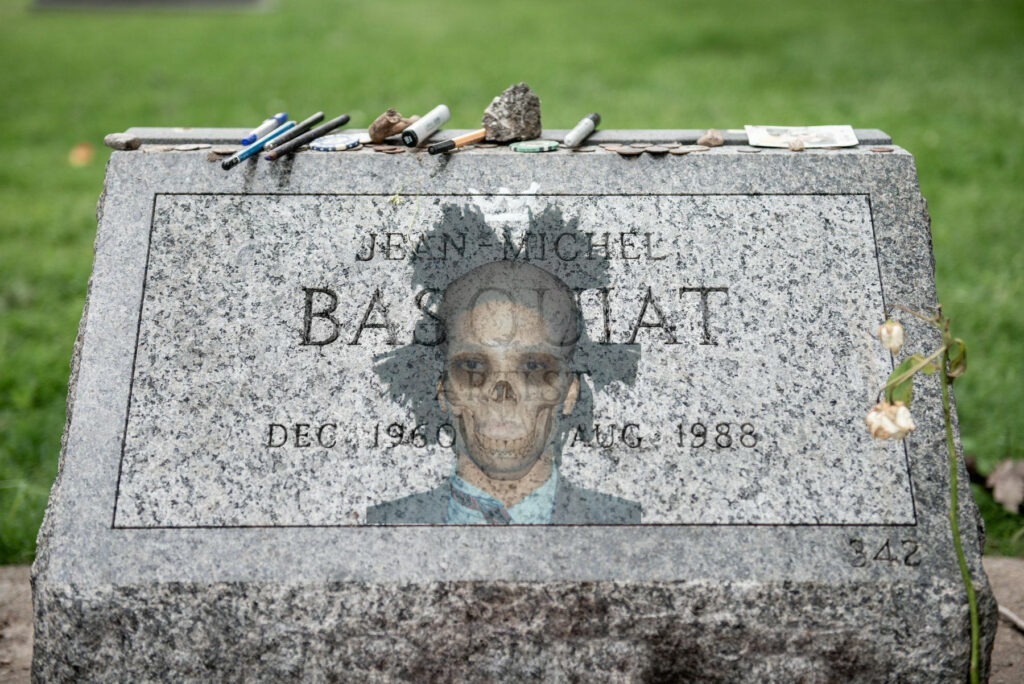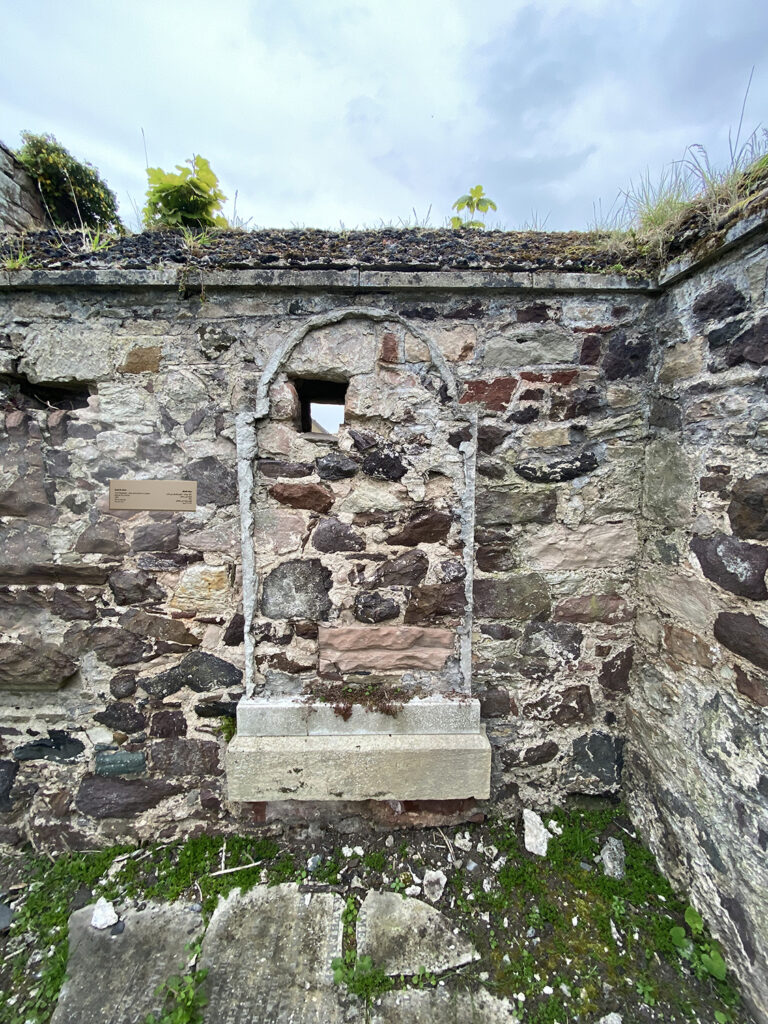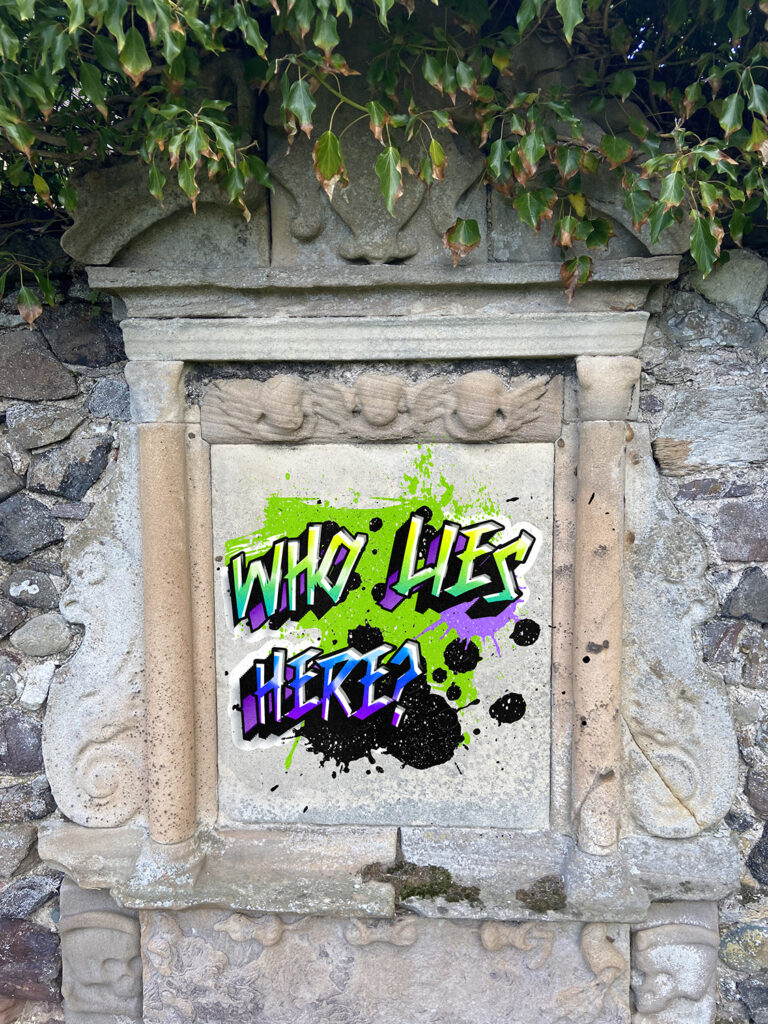This month I was laid low with Covid so decided to work indoors. I adapted my process to construct some works on the computer using my own photographs and some found images.
In constructing these works I was interested in exploring the idea of the graveyard and what this space means to the living. For anyone who has spent time visiting graveyards they have a unique atmosphere. At one and the same time these spaces are about dead people, memory and alongside memory, forgotten memories, neglect and decay. Graveyards are also spaces which seem to exist outside the realm of normal social spaces. People go there who might want to avoid being seen and recognise that graveyards are not often visited. A term my tutor used previously when providing feedback has stuck with me. “The graveyard as a stage”.
My first two works use a known grave of American graffiti artist Jean-Michel Basquiat. I have used his gravestone as a canvas onto which to overlay different ideas. Firstly, I took one of his own artworks and added and shaped it as a new layer to add to the bare facts of the original gravestone.

Jean-Michel Basquiat grave with added artwork
In my second attempt I have used the gravestone with an actual image of Basquiat layered with a skull to represent the decay of the body. It is interesting to me the gravestones I have seen and photographed which contain little sense of a person. A name, dates, maybe other family members is very common. Images of the dead are much less common. It is also interesting that people who visit his grave leave artefacts on top. I wonder if this turns the gravestone into a different type of memorial? More of a ‘live’ shrine. It is however interesting to me that as an artist famous for graffiti, nobody has left permanent marks on the stone.

Jean-Michel Basquiat grave with image of the artist and a layered skull
My next attempt reimagines the grave of Karl Marx which is in London’s Highgate Cemetery.

Kark Marx’s Grave aged and forgotten
I have taken his grave and introduced cracks into the stone and show the grave overgrown with plants. My choice of plants includes the Yew which has mythological connection to death. To the Celtic people the yew was seen as a gateway between life and death. I don’t think I have explored this concept to it’s fullest degree but this was an early attempt to shape my view of the decay of a grave with specific plants.
I imagined people in the future rarely visiting this space and wonder what they might think of this grave with a carved head overgrown with moss. Karl Marx is familiar to us but might not always be familiar.
Through my use of this famous gravestone I aim to encourage thoughts about the memories of people who had no fame in their lifetime. If even Marx’s grave can decay to become anonymous, then the same can happen to the memory of every one of us.
My next three examples use local graves I photographed before this Covid found me. These images show what I call lost burials. The grave marker is worn to nothing and in one example the marker has fallen off the wall and is completely missing. These ideas expand on idea of making new uses of the graveyard whether as a stage or gallery or as a quiet place to vandalise these stones and in that act, giving the graves new meanings.
In my first example below, I imagine the graveyard as a gallery and have added the kind of label found in galleries and exhibitions. The specific label I have used comes from an exhibition in Doha in Qatar so the label has no possible connection with the outline of the missing gravestone. I use this label as a kind of counterpoint to imagine the empty grave marker as a framed but empty artwork. The fact that label does not match what we see introduces tension and confusion. This, to me, illustrates the endless unknown possibilities surrounding the person buried here and what they might have experienced in life.

Unkown Grave as Art
In the example below I have replaced the missing grave marker with a photograph. This photograph is in itself lost. I bough some images online which were otherwise destined for the skip. I do not know any of the people in this photograph nor what the occasion is. It is a photograph lost in time and place and in many ways mirrors the lost grave marker and the unknown person buried here. I have scratched the faces of three of the people in this photograph and left the final person clear. My idea here is questioning memories of the dead. When someone dies, they view we have of them in our heads can change and fade. We might replace that memory with a photograph. My work here questions what we remember and what we do not remember through the use of photographs.

Unkown Grave with Scratched Photograph
My third work uses a stone where the carved words have eroded to nothing. I have imagined the blank stone as the canvas used by a graffiti artist who asks the question, “Who Lies Here”. This graffiti was created on my computer as I imagine daubing a grave with paint would be frowned upon! The graffiti is a visualisation of my thoughts as I wander around graveyards thinking of the forgotten people no longer visited, the gravestones uncared for. At same time, I can imagine the outcry in the press should anyone use gravestones as a canvas in this way. A special place, uncared for and forgotten but with strict rules around what can be done here. A strange contradiction it seems to me.

Unknown Grave with Graffiti
I have another related idea I want to try using a mirror in place of the missing grave marker. This would work on different levels. The mirror set within the graveyard is designed to function so that audience see themselves and place themselves in that space. Photographically the idea of the mirror echoes the mirror within the camera and also the sense that the photograph itself is a form of mirror to reality. I have a few tries at this but couldn’t complete this on my computer to my satisfaction. I think the mirror would have to be in same place as grave and then be photographed. I do not then know if this would work because a photograph of a mirror is no longer a mirror. One for me to think on.
Post script 4th August
I was out walking the dogs today and as my mind emptied with just my footsteps and the changing landscape to focus on, I started to consider my creative works and my research. I thought of my work this month and trying to engage with death. I thought back to when I started on Level 3 and my thoughts on using medical scans. This most basic kind of photograph strips away the body into constituent parts, unpeeling us and presenting a view of things that cannot be seen with the naked eye. The medical scan pares away the sense of the individual and what makes each of us unique. When I look at a medical scan I do not even know if it is depicting someone who is alive or is dead. Death does a very similar thing. When we are dead, the body might be disposed of by burial or cremation and our physical side vanishes. What then is left of any of us after we die? The memories of those still alive who knew us. Such memories vanish as these people live their lives and then die. What else is left of us? Some photographs, some words said at our funeral or in an obituary or carved onto a gravestone and maybe some objects which in life had relevance for us. How can any of these summon up our essense? The words at our funeral vanish as soon as they spoken, people who recognise us in photographs move on then die. To the medical scan, words are often added; our name, date of birth, medical number, medical condition. Just like the words left behind by death, there words are not us, they cannot scratch the surface of what we are or have been. Even these scant facts such as medical records, photographs or words are, in time, all lost and there is no link back to us. The memory of us fades and it is as if we have never lived. This reminds me in a photographic and artistic sense of the vast segments of society who are never recorded in life. In an anthropological sense, we born from nothing and in death we return to nothing. Should we expect any record of having lived? It doesn’t matter to the dead but I reject the idea that we should only remember the famous or the rich and that everyone else doesn’t seem to matter.
This is the why of my work. It started by considering my daughter to find a way to show the person within the medical scan and has evolved and is about trying to give a new meaning to the dead whose bodies were placed in those graveyards by loved ones but have been forgotten and their graves abandoned. My next question is how I go about this?
One other thought on this. I would never amend my plan to include tasks for things such as consideration, time for thought or reflection. It seems to be too exact and inflexible a plan. I don’t believe a plan needs to be too granular and include every single detail and such basic tasks. However, I do think there is space for reflection and maybe this is something I will spend more time recording in this second half of unit.